|
|
#1 |
|
Members
Join Date: Oct 2009
Posts: 153
|
HI all,
The many rugs with «small Holbein pattern» featured in Renaissance paintings are mostly attributed to Ottoman- / Anatolian- weavers and so are roughly 70 extant rugs and fragments of the type (1). In the essay, I hinted at a possible alternative main source: Timurid Persia, with later migration of the pattern to Anatolia and even to Spain (2) during the fifteenth- or sixteenth century. In fact, among experts there are diverging opinions (what did you expect ?): - Amy Briggs (3) using her exhaustive review of Timurid miniatures concluded that the «small Holbein pattern» was one of the most frequently used rug motifs during the Timurid rule of Persia. -Christies‘ experts, among others, seem to share Briggs’ views: « The 'small pattern Holbein' design is one which is part of the international Timurid style. Amy Briggs in her seminal article clearly demonstrated the link between the 'small pattern Holbein' rugs and Timurid Persian arts » (4) -Eleanor Simms, for example, disagrees: « The validity of using pictorial art as a source of evidence for textiles that no longer survive is,..., questionable at best ». (5) In the following, SHR = Small Holbein Rug. - Even a quite superficial survey of Timurid miniatures reveals a great number of SHRs. Far from being standardized, the pattern shows variations in details which suggest that real rugs were copied, not any academical standard. (FIG 1 and FIG 2.) Red and blue are often, but not always dominant field colors (green, as in FIG 2H.) FIG 1. Timurid. 1429. Herat school. Baysungur in a garden. Detail . 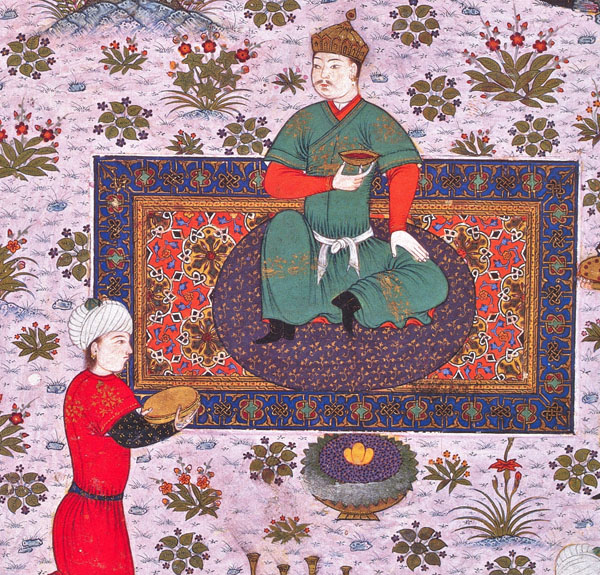 FIG 2. Various Timurid « small Holbein» patterns 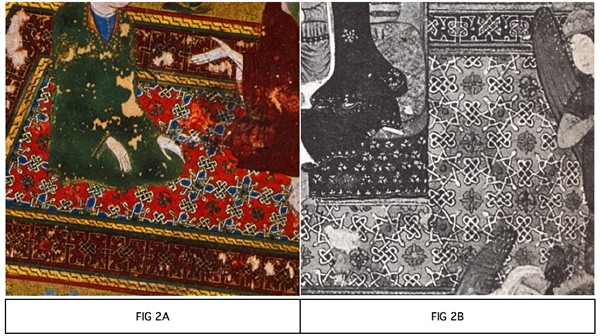 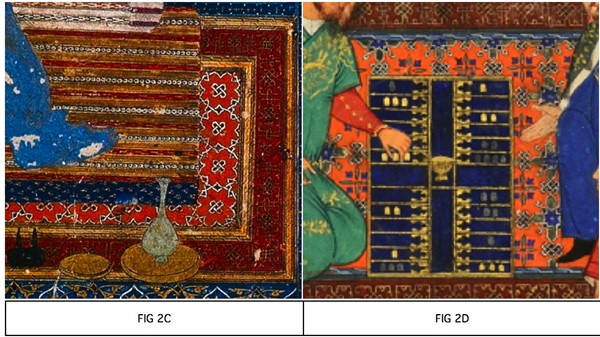 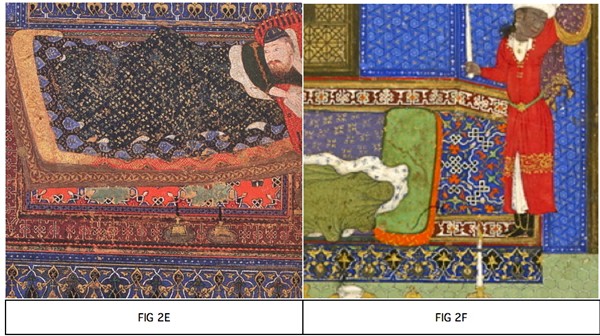 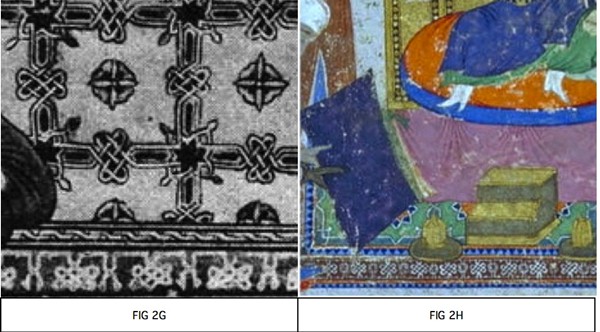 - SH is clearly the most frequently used rug field pattern illustrated by the painters of the Timurid Royal Libraries (kitabkhana). If one remembers that these Royal Libraries were an important tool for regime propaganda for all Persian dynasties (6), (as were the royal rug factories), one can perhaps assume that the rugs featured in the miniatures were not picked at random, but rather supposed to make a statement. - A couple of SHRs are found in even older Persian miniatures, dating from the Il-khanid period and from the period immediately preceding the Timurid Empire. This indicates that the SH pattern was known and used in Persia before the founding of the Timurid Empire (and well before the creation of the Ottoman empire in Anatolia, by the way). FIG 3: Pre-Timurid «small Holbein rugs» 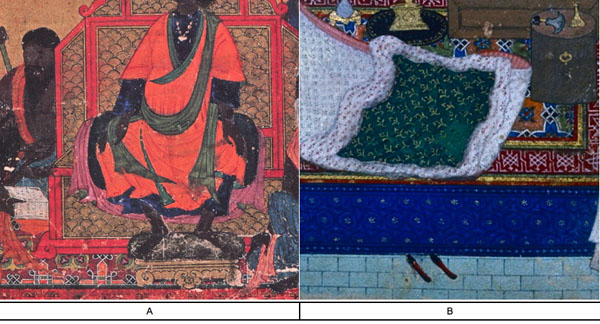 - According to J. Mills (7) the first SHR in European painting dates from 1451 and the bulk of them were painted between 1451 and 1550. Thus, many miniatures featuring SHRs pre-date their first representations by European masters by 40-75 years. - One of the characteristics shared by extant SHRs, those illustrated in Timurid miniatures and in European paintings, is the ubiquity of the kufic border. Although kufic borders appear in some para-Mamluk rugs and in a limited number of Anatolian- or Spanish fifteen- and sixteenth century rugs featuring other field motifs as well, they are extremely frequent in illustrations of Timurid rugs, independently of the field motif. IMHO one could perhaps even consider that a kufic border in a (15th-16th century-) SHR is a strong presumption of Persian- (Timurid-) rather than Anatolian- (Ottoman-) origin. - Even if the reader accepts to walk with me on that thin ice, agreeing that the earliest SHRs with kufic borders may indeed have been woven in Persia and not in Anatolia, he would probably mention the fact that the roughly 70 extant SHRs (including fragments) surely must have been woven with symmetrical knot, since so many experts attribute them to Anatolia. To competently discuss this fine point there are much more knowledgeable people than me here on Turkotek, but I was under the (mistaken?) impression that, even though classical Persian workshop-rugs were woven with asymmetrical knots at least since the Safavid period, there are, still today, several Persian clans and tribes which use prevalently the symmetrical knot (the Luri for example?). One could also mention that Timurid Greater Persia included regions which (today) use mainly the symmetrical knot, in particular in the Northwestern area of the former Empire. Since we know only one rug fragment tentatively attributed to the Timurid period, what proof do we have that Persian Timurid rugs were not, at least in part, woven with a symmetrical knot too? FIG 4. Map of major extension of Timurid Persia 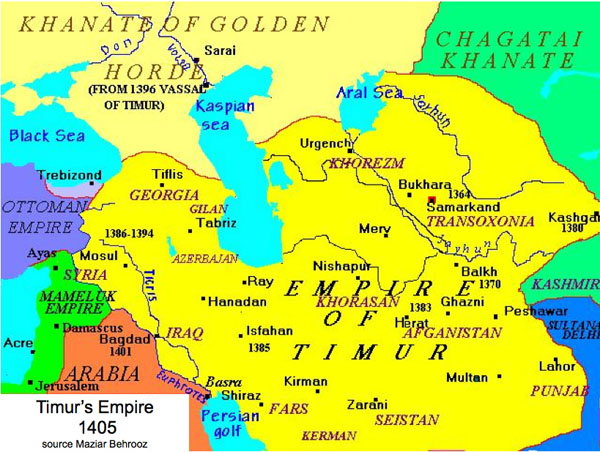 If the possibility of a Persian origin for the SHR rugs is accepted, one can walk a little bit further on this thin ice and look for a credible cradle inside Persia. I would propose two options, which both respect the main characteristic of Rugdom Science (A total lack of proof  ). ).A:Timur’s clan fiefdom: The founder of the dynasty was a prominent Barlas tribesman, a Turco-mongol clan (more Turkik than Mongol) established in Transoxiana, around Kish, southwest of Timur’s capital Samarkand, towards the Amu-darya. The base for my fragile theory would be that Timur might have imposed to his kitabkhana painters to feature his clan’s traditional rugs (or alternatively that the painters did it to flatter the boss and his clan). Martin, in a recent thread about kufic borders, made a fascinating remark, noting that the field-patterns of Timurid SHRs show interesting analogies with some extant Turkmen khali. Could the fifteenth-century Turkmen (who already lived nearby in the trans-Caspian area, at the time) have been influenced by their powerful southeastern neighbors (and nominal suzerains) and copied / interpreted their rugs? or B: The northwestern part of the Timurid Empire: In this area, still today, the symmetrical knot is sometimes in use. This area includes Tabriz, at the time an important city, which together with Herat was home of the most important Timurid kitabkhana. Perhaps the painters reproduced the best rugs they saw in the Tabriz bazaars or in the elite’s homes? One weak point in this theory is that many miniatures featuring a SHR are attributed to the Herat kitabkhana too. A fact which rather supports option a). On the other hand the few SHRs illustrated in pre-Timurid miniatures (FIG 3) are attributed to the Tabriz school. A point in favor of option b). Litterature 1) According to Charles Grant Ellis, cited in Christies’ catalog, May 2003. 2) At least one fifteenth-century extant SHR (today in Boston museum) was woven with Spanish knot. 3) A. Briggs. Timurid Carpets I: Geometric Carpets, Ars Islamica 7, 1940, pp.20-54. Mrs Briggs’ publications are extremely difficult to find today. She is cited by many authors, but I wonder how many of them really own a copy. I don’t. 4) Christies. May 2003 5) E. Simms. Encyclopedia Iranica. Carpets viii. The Il-khanid and Timurid Periods. Vol. IV, Fasc. 7, pp. 864-866. Mrs Simms is surely right when she cautions us not to believe that rugs illustrated in Timurid miniatures were exact reproductions of the real thing. In fact, the colors of the miniatures were dictated by the nature of the mineral pigments used , which were mostly much brighter than whatever can be done with natural wool dyes. (Especially the reds, the blues and the gold-yellows). However, these rug illustrations also show a remarkable consistency of design, (with enough little variations to suggest a real model), both in the field patterns and in the systematical choice of a kufic border (About four different kufic «scripts» are met). 6) The Princely vision, Persian Art and Culture in the fifteenth century pp. 32-50, «.... From the earliest periods, Muslim powers united political activity with an interest in books. Accordingly it was the staff of the kitabkhana, painters and calligraphers in particular, who were charged with visualizing princely aspirations and affirming ruler’s legitimacy and power....» . Timur and his immediate successors were particularly aware of the importance of regime propaganda by means of spectacular architecture, lavishly illustrated manuscripts and rich artifacts, certainly including rugs. Later, the Safavid Shahs, especially Shah Abbas, shared this opinion. The latter is said to have personally influenced the design of rugs woven in his royal factories. 7) John Mills, 'Small Pattern Holbein Carpets in Western Paintings', Hali, vol.1, no.4, pp.326-330 _____ Illustrations: FIG1: 1429. Timurid. Herat school. Baysungur in a garden. Detail . FIG 2A: 1425. Timurid. Herat school. Poet Sa'di and friend. Detail. Chester Beatty Lib. Dublin FIG 2B: 1427-1428. Timurid. Herat school. Humay in palace of fairies. Detail. Vienna Nationalbibliothek FIG 2C: 1427. Timurid. Herat School. Drunken prince and maiden. Detail. Chester Beatty Lib. Dublin FIG 2D: 1427. Timurid. Herat school. Princes playing games. Detail. Berenson collection. FIG 2E: 1434-1440. Timurid. Herat school. Tahmina enters Rustam’s chamber. Detail. FIG 2F: 1444. Timurid. Herat school. Firdawsi's Shahnameh. Detail. Royal Asiatic Soc. London FIG 2G: 1450-1470. Timurid. Herat school. Detail FIG 2H: 1469-1470. Timurid. Jamshid instructs his people. Detail. Chester Beatty Library FIG 3A: 1330-1340. Il-khanid. Tabriz school. The Indians. From a "kalila wa dimna". Detail. Istanbul FIG 3B: 1370-1375. Chubanid. Tabriz school. Cobbler cuts the nose of barber’s wife. Detail. Topkapi. Istanbul |
|
|

|
|
|
#2 |
|
Administrator
Join Date: May 2008
Location: Cyprus
Posts: 194
|
Nice investigative job, Pierre.
 I don’t know the provenance of the Small Holbein pattern, but you have found an important fact: the Il-Khanid miniatures of Fig 2 demonstrate that it existed already in the region of Tabriz between 1330 and 1375. So, for a possible origin, I would start from there. And that is before the Timurids isn’t it? (1) The subsequent Timurid miniatures confirm that the SH pattern – always together with a kufic border - was still in use a century later. I rather doubt that Timurids bought their carpets from Anatolia, so isn’t preposterous to presume that they should have been woven in Timurid territory. From there the pattern must have been exported to other weaving nations, such as Ottomans and Moorish Spain. Regards, Filiberto (1) - Mrs Eleanor Simms, objection « The validity of using pictorial art as a source of evidence for textiles that no longer survive is,..., questionable at best » cannot apply here: those are SH rugs. Unless the miniaturists had the gift of divination and were depicting future rugs, that is. |
|
|

|
|
|
#3 |
|
Members
Join Date: Oct 2009
Posts: 153
|
Hi all,
In an interesting paper dealing mainly with Seldjuk architecture and rugs, J. Taylor (1) shows an extant fragment, probably woven after the Seldjuk period, but nevertheless likely to be very old (There is no mention of the results of any C14 test in his paper). Taylor considers that it might be one of the oldest Anatolian rugs featuring the small Holbein pattern and the closest to the Timurid style. One might argue the second point: Unlike a few other supposedly Anatolian SHRs this rug does not feature the usual white kufic border. However, the peculiar border particularly attracted my attention: Although it shows a superficial analogy to a "running swastika" motif or to the «Hittite» border motif of the lost rug formerly in the Berlin museum (shown yesterday in another thread) this border might be another example of a motif derived from an arabic script. Could it be  ? ? Hi Filiberto: I fully share your opinion, there is a good likelyhood that the SH pattern originated in pre-Timurid Persia and for unknown reasons got highly popular during the Timurid period. (1) John Taylor rugbam.blogspot.com/2012/05/ |
|
|

|
|
|
#4 |
|
Members
Join Date: Jul 2008
Posts: 121
|
Hi Pierre
I agree, if this border is seen in relation to the other anatolian seljuk rugs I would see it as a kufic ornamental motif, derived from mirrored alif/lam. The motif makes a color shift between background and foreground in horizontal and vertical border. And for me that makes more sense than seeing the border like singular motifs, than as a rather messed up "running swastika border". 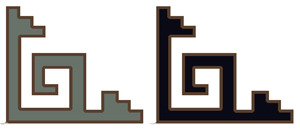 The pointed ends of the motif is zig-zagged, which could be a simplified imitation of foliated kufic. Looking at other 45 degree lines in the rug layout, the weaver had not problems making 45 degree lines appear strait, so the zig-zag is intentional. I would probably have had found the similarity of this border to kufic ornamentation a bit to generic if it wasn't for all the other minor borders in the Seljuk rugs which also in various ways variates the kufic motif . best Martin |
|
|

|
|
|
#5 |
|
Members
Join Date: Oct 2009
Posts: 153
|
Hi Filiberto,
Quote: «...I rather doubt that Timurids bought their carpets from Anatolia, so it isn’t preposterous to presume that they should have been woven in Timurid territory....» I strongly agree: for any Persian, importing rugs from Anatolia must be tantamount to importing cheese from the U.S. for a (true) Frenchman  . .Hi Martin, I assume that the structure analogy (with primary and secondary «guls») between many Turkmen rugs and the (field-) pattern of the small Holbein rug above has not escaped your attention and neither did it come as a surprise. Best regards Pierre |
|
|

|
|
|
#6 |
|
Members
Join Date: Jul 2008
Posts: 121
|
no Pierre I will certainly not forget the later Turkmen rugs in this
 But bear with me I am terrible slow, and I first have to look into Volkmar Gantzhorn (with whom I of course strongly disagree) and F.R Martin and R.M. Riefstahl (who in my opinion got it right in the first place). I have just today got a hand on Riefstahls 1931 article Primitive rugs of the "Konya" type in the mosque of Beyshehir But bear with me I am terrible slow, and I first have to look into Volkmar Gantzhorn (with whom I of course strongly disagree) and F.R Martin and R.M. Riefstahl (who in my opinion got it right in the first place). I have just today got a hand on Riefstahls 1931 article Primitive rugs of the "Konya" type in the mosque of Beyshehirbest Martin |
|
|

|
|
|
#7 |
|
Members
Join Date: Oct 2009
Posts: 153
|
Hi Martin,
Coming back to the border of the Small Holbein rug shown in J. Taylor's paper (found in Beysehir, Anatolia): It has a rather close parent, a small fragment found at Fostat (Cairo), dated from the fifteenth century, of which Aslanapa (*) shows a drawing:  This fragment further reinforces the hypothesis that these borders derive from script, no?. Best regards Pierre (*)Oktay Aslanapa. "One Thousand years of Turkish Carpets" Drawing 22, page 64. |
|
|

|
|
|
#8 |
|
Members
Join Date: Oct 2009
Posts: 153
|
Hi all,
While browsing, once more, through my copy of Lentz and Lowry’s outstanding and superbly illustrated book «Timur and the Princely Vision (1), I was happy to find the following comments about Timurid rugs. Apparently this dilettante wasn’t walking on too thin ice after all.  I have taken the liberty to add some suitable additional illustrations and a few comments to their text. Page 220 «……The kitabkhana was also involved in the design of royal carpets….» «…Evidence from paintings (miniatures) shows two dominant groups of Timurid carpets: an earlier geometric tradition, featuring inner fields with small repeating patterns edged with kufic-inspired borders…» FIG 1. Timurid. 1429. Herat school. Baysungur in a garden. Detail .  By the way, this design obviously even pre-dates the Timurid Empire in Persia, since as Filiberto rightly once noted, miniatures of the Jalayirid and -Chubanid periods (2) already do feature it. FIG 2. Chubanid period. 1370-1375. Tabriz school. The cobbler cuts the nose of the barber’s wife. Topkapi. Istanbul. 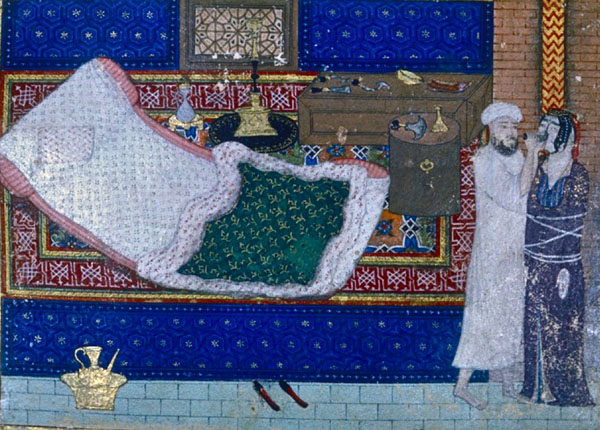 «…and later arabesque carpets, their designs featuring variations of circles and cartouches edged with arabesques…» FIG 3. 1488. Late Timurid period. Herat school. Party at the Court of Huseyn Mirza.Detail. 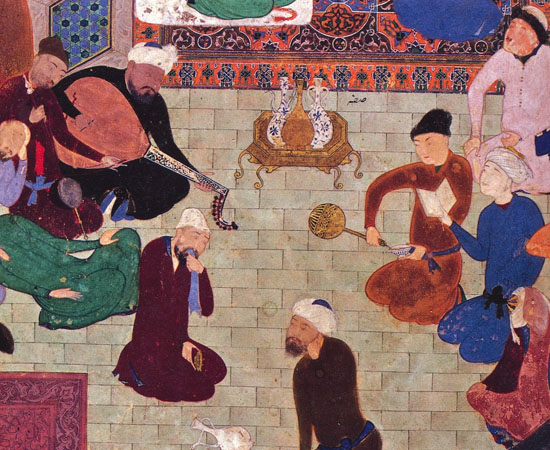 FIG 4. 1445-1446, Timurid. Herat school. Khusraw receives Farhad. 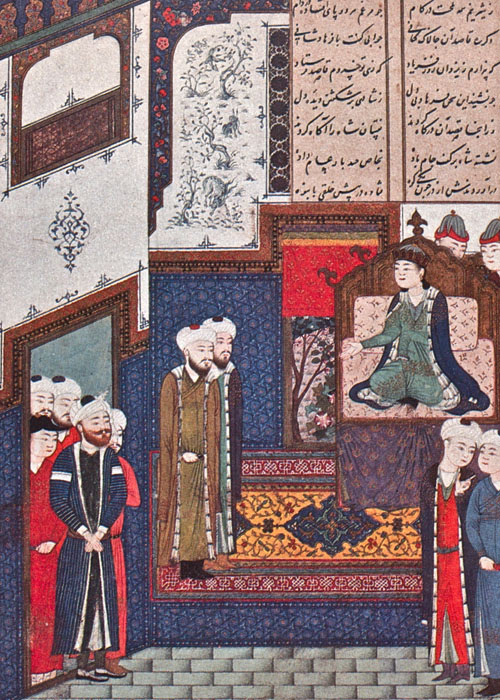 «…These later fifteenth century arabesque examples have affinities with kitabkhana efforts in book illumination and would serve as the basis of the spectacular Safavid carpet tradition, …» And to the Ottoman tradition to boot, if I may add. FIG 5. Illuminated panel from a Bustan of Sa’adi (detail). Herat 1488. Timur and the Princely Vision, page 190. 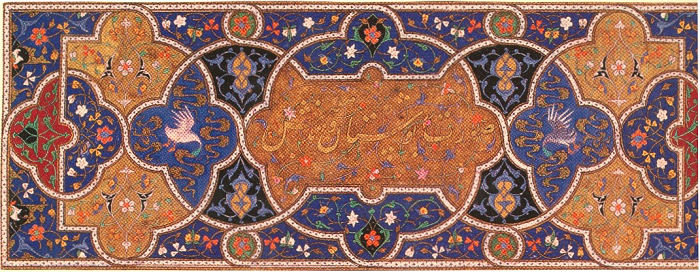 FIG 6. Illuminated page from a Khamsa of Nizami. Herat. 1431.Timur and the Princely Vision, page 205. 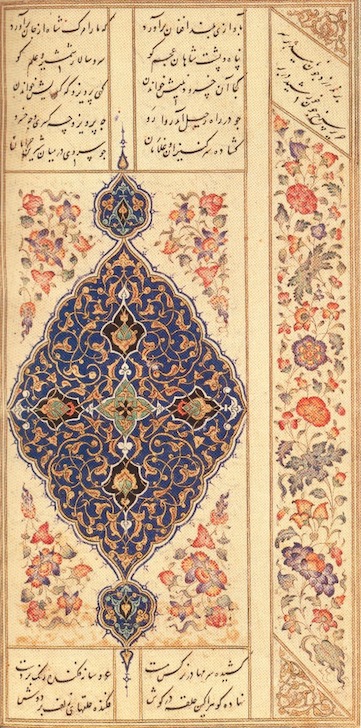 FIG 7. Ottoman Court rug. Selim II ascent to the throne. 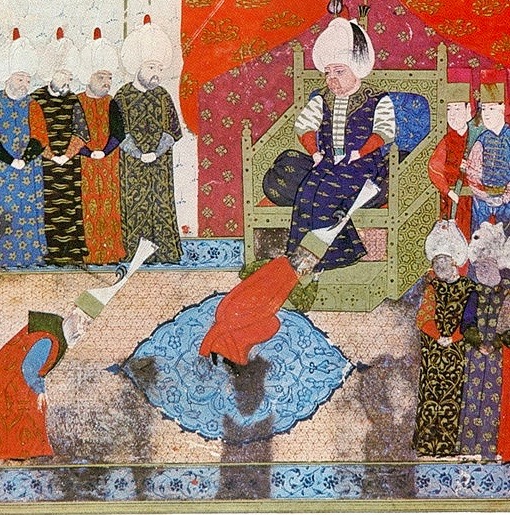 «….but the same cannot be said of the geometric examples, whose vigorous, knotted forms may represent an older nomadic strain, one stubbornly resistant to the aestheticism of court art….» Page 221 «…Despite their ubiquity in contemporary painting, there are no generally recognized surviving Timurid carpets. (2) The painted depictions of these geometric carpets, however, show remarkable similarities to the small- pattern Holbein carpets (as well as the related Damascus, or so called Para-Mamluk, carpets)….» FIG 8. 15th century. Small Holbein pattern. «Vakiflar Museum Teppiche», B. Balpinar & U. Hirsch.  FIG 9. 1460. Botticelli. F. de Montefeltre and Landino. Vatican. 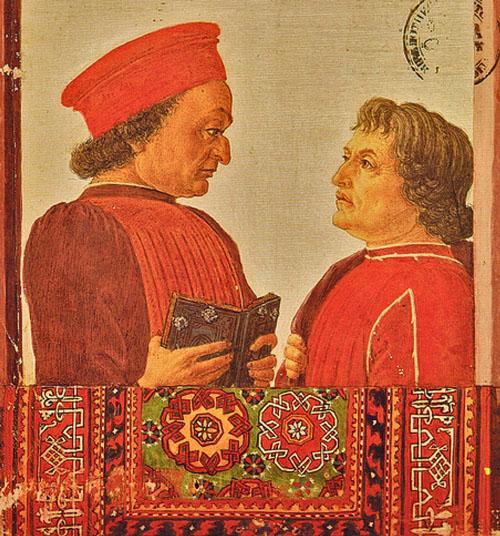 «…..Said to be from Ottoman Asia Minor, these small-pattern Holbein examples were especially favored in western Europe and are found in paintings there from the 1450s. Little is known of the origin of their design or the provenance of the carpets, but the patterns and colors often reflect Timurid taste and designs. Since current research suggests that many small pattern Holbein carpets can now dated to the fifteenth rather than sixteenth century, (3) some of the roughly fifty surviving intact or fragmentary examples may be Timurid. While past research has emphasized knotting technique to demonstrate provenance, carpet weavers captured during Timurid campaigns would have continued to weave in the technique in which they were trained. ….» References (1) T.W. Lentz &G.D. Lowry. «Timur and the Princely Vision. Persian Art and Culture in the Fifteenth century» 1989. Smithsonian Press. (2) The Chubanid- (In northwestern Iran) and Jalayirid- (around Baghdad) States were splinters from the decadent Il-khanid State. Both were terminated by Timur. (3) F. Spuhler «Carpets and Textiles» in the Cambridge History of Iran. 1986.,6, 698-700. (4) R. Pinner & J. Stanger «Kufik borders on Small Pattern Holbein» Hali I, 1978, 335-358.. Last edited by Pierre Galafassi; February 21st, 2017 at 04:20 PM. |
|
|

|
 |
|
|